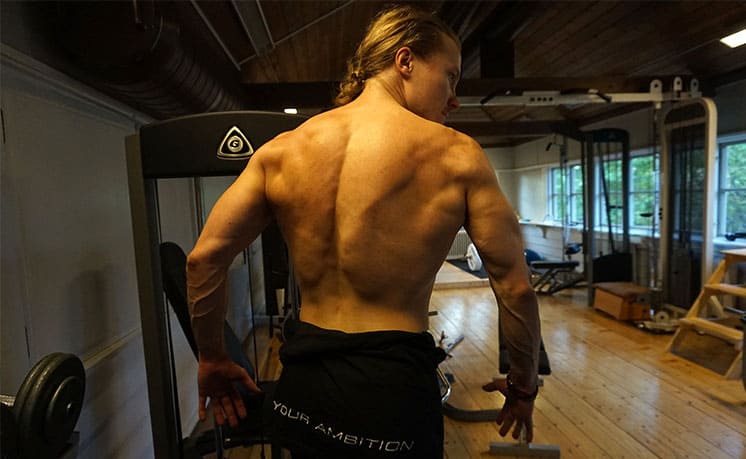
When it comes to building muscle people often wonder how many sets per muscle group they should do to see the best results. This is something that I’ve been thinking about myself for a long time now, so I decided to find out what the best number is. Here’s what I learned:
How Many Sets Per Muscle Group Should You Do To Build Muscle? A physically inactive beginner can build muscle with as little as 1 set per muscle group per week. If however you’re looking for optimal muscle growth, then research suggests that you should do between 10-45 sets per muscle group per week depending mostly on training experience and genetics.
So as you can see, the more effective training you do, the more muscle you’ll grow. But there is one caveat (of course):
That more training volume (sets and reps) is only better up to a point.
If you do to much, overtraining with all it’s unpleasantries will eventually becomes a problem… But on the other hand, if you do to little, you’ll leave gains on the table…
So the question becomes:
How many sets per muscle group should you train with in order to build muscle quickly, safely and effectively without getting overtrained? Well, that’s exactly what we’re going to look at in this post (and video.)
So, let’s dive right in…
Table of Contents
How I Stopped Being Overtrained And Started Building Muscle Instead
Before we look at how many sets per muscle group you should do. Quick backstory:
During the first couple years of my fitness journey I struggled building muscle.
In fact, here’s a comparison picture of my physique when I started and after I’d been lifting for almost one year:
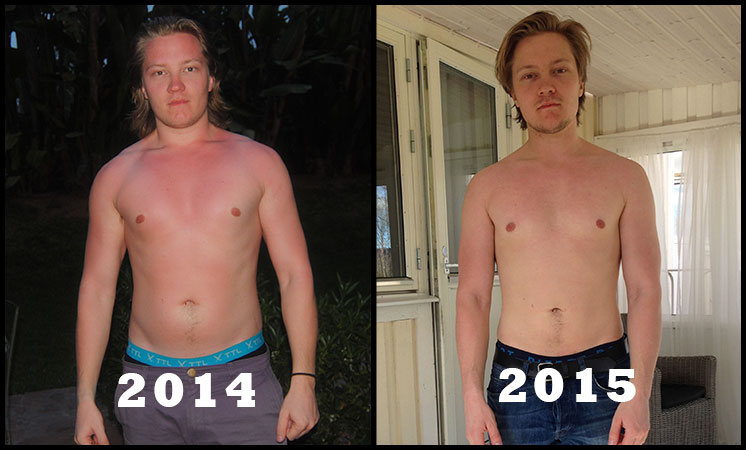
As you can see, not that much muscle was grown, in fact I remained skinny fat during an entire year…
And here’s why that sucked big time:
During the first year of solid strength training you should be able to add between 20-25 lbs (8-10 kg) of muscle to your frame.
| Years of Training | Maximum Muscle Growth Potential |
|---|---|
| Year 1
Year 2 Year 3 Year 4 Year 5+ |
20-25lbs (2lbs per month) / 9 – 11 kg (0.9kg per month)
10-12lbs (1lbs per month) / 4.5 – 5.5 kg (0.45kg per month) 5-6lbs (0.5lbs per month) / 2 – 2.7 kg (0.22kg per month) 2-3lbs / 0.9 – 1.3 kg 2-3 lbs / 0.9 – 1.3kg |
Lyle McDonald’s famous “maximum potential muscle growth per year” table.
That’s a lot!
So, now you might wonder:
Why didn’t I gain all of this?
Well, because I trained to much, to early…
I Was Overtraining
One of the biggest struggles I had in the beginning of my fitness journey, which is also extremely common, was that I wanted things NOW, or preferably yesterday…
This mindset is very dangerous, and when it comes to training I paid for it, by staying plateaued in my lifting.
I remember training so much that the level of fatigue I accumulated got way out of hand.
Quickly I started noticing the classic overtraining symptoms, such as bad sleep, huge mood swings, feeling stressed, constant colds etc.
This went on for almost a year, because my thoughts was:
“Well it’s supposed to be tough, and the more training I do, the more I’ll grow!”
It wasn’t until I got my ego in check and asked myself; maybe I need to back off? This obviously doesn’t work, and I feel like shit.
So, fortunately I did, and in the meantime I started to educate myself on how to program my own training.
During this time I learned that in order to build muscle at the quickest rate possible, I need to do enough volume to drive adaptations, but not more than what I can recover from.
And that’s what I started to do.
The results?
Well, I started gaining muscle quicker than ever before. And best of all, I started to feel great as well.
Here’s a picture after one year more, this time with correct set up training volumes for me:

So, how much training should you do to not only maximize muscle growth, but to also feel well in the process?
Well, let’s look at that now:
Number of Hard Sets Per Week: The Best Way to Define & Measure Training Volume For Muscle Growth
Before looking at the amount of training you should do. Let me quickly explain why I think number of hard sets per week is the most convenient way to define and measure training volume when it comes to muscle growth.
What is a hard set?
A hard set is when a set is taken either close to, or to the point of muscular failure. This means that the set will be so fatiguing to all the muscle fibers that it’ll stimulate maximum muscle growth:
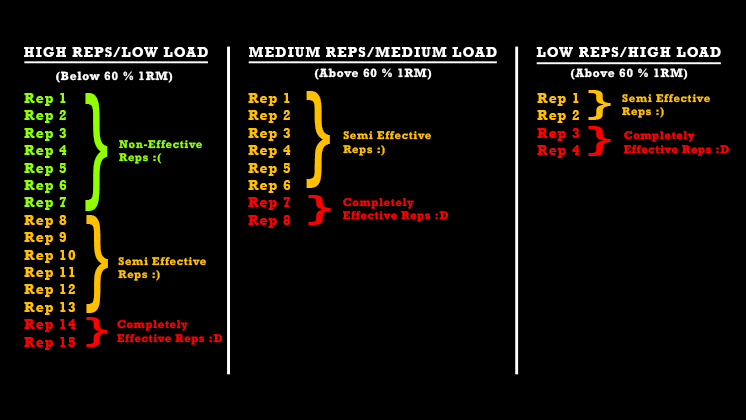
And here’s why hard sets is a great measure of training volume:
A while back Greg Nuckols wrote an awesome article called “Can we predict muscle growth?”
In the article he basically concludes that; out of all the ways that we can measure training volume when it comes to muscle growth, number of hard sets probably do so the best.
And here’s why:
Number of hard sets takes different exercises into consideration
It’s been shown that for muscle growth specifically, the exercises you choose doesn’t matter that much, as long as they target the muscles you want to train effectively.
For example:
If you want to grow your chest, you will grow equally well from a challenging set of barbell bench press as you will from a challenging set of dumbbell bench press.
So, when it comes to quantifying and measuring the amount of training you do. One set is pretty much equal when it comes to growth across different exercises. As long as the exercise is effective, meaning it allows you to safely go through a full range of motion, with a heavy enough weight that are known to cause growth. (And heavy enough seems to be when training above 20% of 1RM to failure)
Number of hard sets takes different amount of reps per set into consideration
30 reps taken to failure will cause similar growth as 6 reps taken to failure. The only difference between rep ranges is that it’s more convenient to accumulate enough training volume in the medium rep range (5-12 reps).
So, using number of hard sets is a great way to measure training volume across different rep ranges as well. With two exceptions (of course):
That the higher rep ranges (12>) causes a bit more “junk volume”, meaning a lot of ineffective reps, while these reps simultaneously uses up a bit of your recovery.
And on the other side, the lower rep ranges (<5) forces you to do more sets in order to achieve enough training volume to maximize growth.
But, if you keep your training mostly in the medium rep range (5-12), then number of hard sets per week becomes a solid measuring tool for quantifying training volume.
Why Number Of Hard Sets Per Week?
So, you might have realized that I prescribe number of hard sets per week.
Why is that?
Well, in simple terms so that you can apply the volume range to your prefered training frequency. If you train a muscle group 3 times per week, you should divide your total number of sets over those days, so that you still work with the correct volume recommendations.
If you want to find out which split or routine that fits your schedule best, check out this post next.
How Many Hard Sets Per Muscle Group And Week Should You Do To Maximize Growth?
When it comes to quantifying training volume for muscle growth, we can nowadays, thanks to the hypertrophy GOD himself Brad Schoenfeld, make decent scientific recommendations based on his publications.
During the last two years Brad has published two awesome papers with the goal to devise evidence based guidelines on training volume for muscle growth.
Paper #1: The Bottom Limit
The first paper was a meta-analysis published in 2017, where Brad and his team pooled all the data from a large number of studies on training volume for muscle growth.
Here’s what they found:
Doing 10 sets per muscle group per week caused more muscle growth than doing 5 sets per muscle group per week:
This shows us that there is a dose response relationship between more volume and more muscle growth. In other words, the more volume you do, the more you’ll grow.
Now, even though these findings are very compelling, this meta-analysis still has a couple of shortcomings:
The first one is that, out of the 15 studies included in the analysis, only 2 was on trained subjects, the rest was on untrained subjects.
And this is very important to take into consideration, because to quote Brad himself:
 “The early phase of training is associated with a different adaptive response compared to the latter stages; thus, you can’t necessarily generalize findings to well-trained lifters.”
“The early phase of training is associated with a different adaptive response compared to the latter stages; thus, you can’t necessarily generalize findings to well-trained lifters.”
And second, they were not able to determine any effects of doing more than 10 sets per week, simply because there wasn’t sufficient research looking at higher training volumes.
With that said though, this meta-analysis still provides us with good enough information to make our first recommendations:
Which is that most beginners and early intermediates should train with at least 10 sets per muscle group per week, if the goal is to maximize muscle growth.
Okay, so now that we got the bottom limit established, let’s look at the top limit:
Paper #2: The Top Limit
In order to outline recommendations on the top limit of training volume for muscle growth, the second paper recently published by Brad comes in handy:
In this study they had:
- 34 males
- 24 years old on average
- 4.4 years of training experience on average
They divided the participants into 3 groups:
- A low volume group – who did 6 sets for upper body muscles and 9 sets for quads per week, spread out over 3 total workouts.
- A medium volume group – who did 18 sets for upper body muscles and 27 sets for quads per week, spread out over 3 total workouts.
- A high volume group – who did 30 sets for upper body muscles and 45 sets for quads per week, spread out over 3 total workouts.
The participants performed these sets to muscular failure, with the following exercises:
- Bench press
- Overhead press
- Wide grip pulldowns
- Seated cable rows
- Back squats
- Leg press
- One legged leg extensions
For a total duration of 8 weeks.
The Results:
For muscle growth they saw, just as they did in the 2017 meta-analysis, a clear dose response relationship between more training volume and muscle growth.
Where the muscle thickness of the participants increased significantly more in the high volume group than the low volume group:
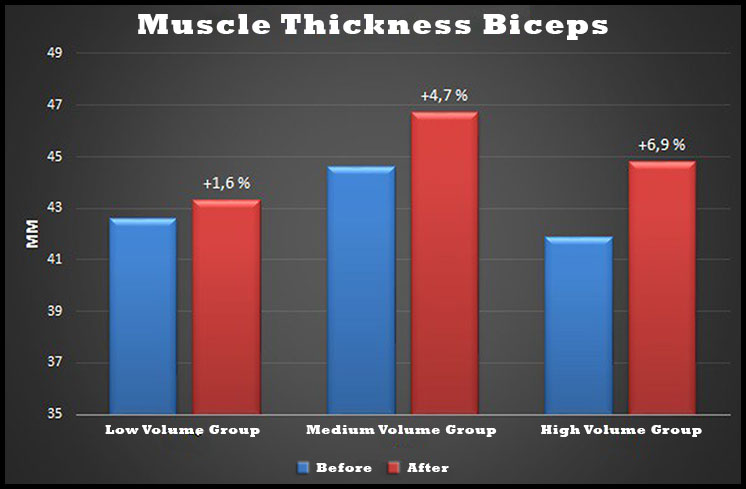
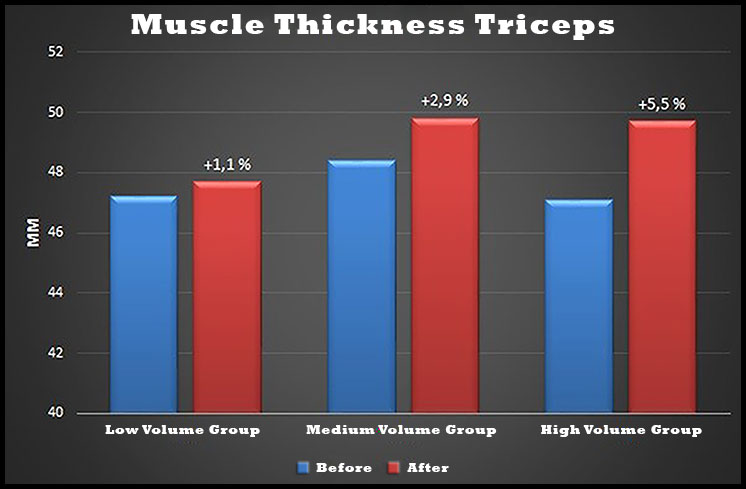
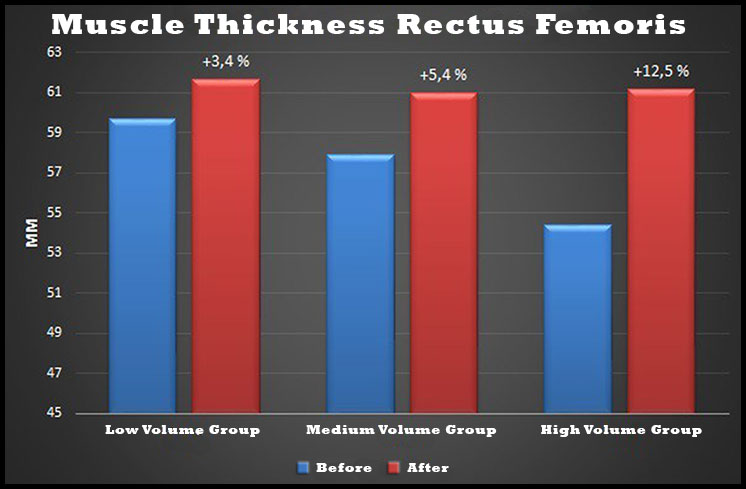
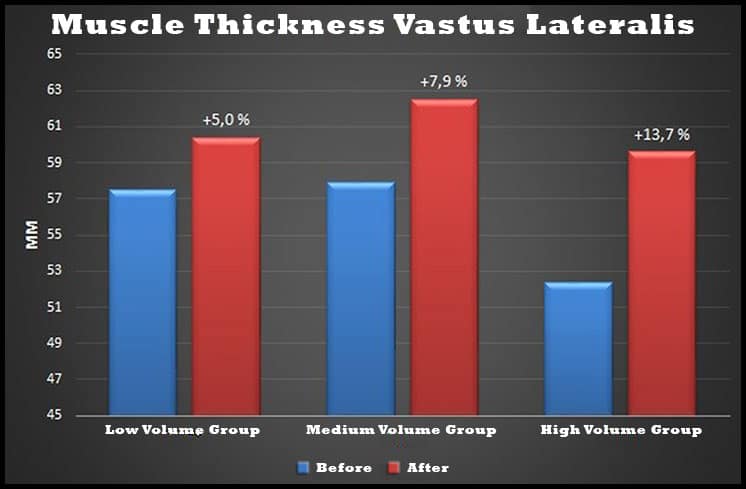
Based on these findings the current recommended upper range of training volume are, to quote Brad’s recently published blog post discussing this paper:
 “Volume is a primary driver of muscle growth, with more sets translating into greater gains. Upper body hypertrophy continued to show beneficial effects with 30 sets per muscle per week and continued lower body gains were seen with 45 sets per muscle per week.”
“Volume is a primary driver of muscle growth, with more sets translating into greater gains. Upper body hypertrophy continued to show beneficial effects with 30 sets per muscle per week and continued lower body gains were seen with 45 sets per muscle per week.”
This is a bit shocking in my opinion.
And here’s why:
Before this study was published, all we had to go on, for recommending top limits of training volume, was anecdotal evidence observed by top level natural bodybuilding coaches.
Their observations was that, on average, once someone pass 20-25 sets per week, they start to experience recovery problems. Which would often result in overreaching and eventually a drop of in muscle growth.
And that’s why the recent study by Brad is a bit shocking.
Or is it really?
The Work to Recovery Equation
Look:
If your goal is to truly maximize muscle growth, you must train with volumes that are high enough to place you just at the brink of where you’re no longer able to recover.
Because when you’re no longer able to recover, that’s when you go into an overreached state. Right before that happens however, that’s when you’re maxing out your muscle growth.
Here’s a great illustration of this:
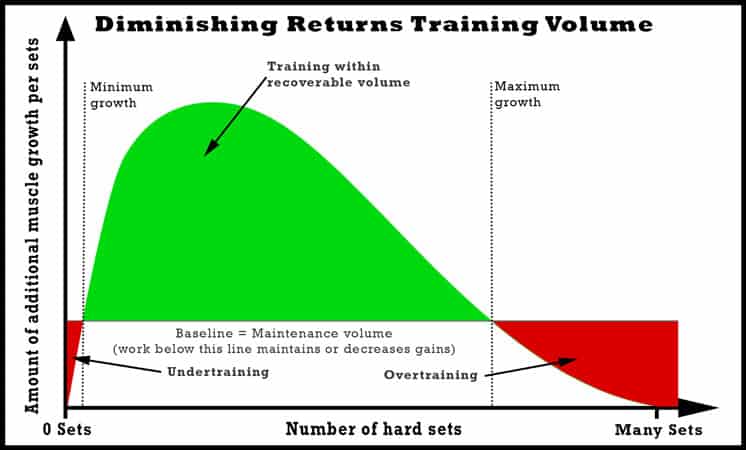
As you can see, the point where the bell curve goes from green to red, is the point where an individual no longer are able to recover. And we’re not yet sure where this will happen on average, (that’s why I put “many sets” as the last parameter.)
All we know at this point, thanks to the study we’re discussing, is that for trained individuals, 30 sets for upper body muscles and 45 sets for the leg muscles (quads) per week, is still somewhere within the green area of the bell curve.
So, we could jump to the conclusion that 30 sets for upper body and 45 sets for lower body (quads) per week, is a decent top limit recommendation for volume, at least for more advanced trainees.
However, we should be carefull doing so, because such high numbers like these might only be doable in the short-term, which is probably also why the anecdotal observations are down at 20-25 sets per muscle group.
And here’s why:
Fatigue Is Accumulative
This study only lasted for 8 weeks, and to quote Brad once again:
 “The human body is very resilient and handles high levels of stress well in the short-term. When these stressors are properly managed, there is a positive adaptive response; in the case of a high resistance training volumes, the upshot is greater muscle growth. However, persistent exposure to such stressors ultimately overtaxes the body’s ability to respond, leading to an overtrained state.”
“The human body is very resilient and handles high levels of stress well in the short-term. When these stressors are properly managed, there is a positive adaptive response; in the case of a high resistance training volumes, the upshot is greater muscle growth. However, persistent exposure to such stressors ultimately overtaxes the body’s ability to respond, leading to an overtrained state.”
In other words, for each session and week that you train with very high volumes close to what you can maximally recover from. You’re essentially digging yourself a little hole in your recovery capacity throughout the duration.
This means that, for example:
On week 2 of a high volume training program, you might be a few sets out from overreaching, you feel fine and are making huge gains! But once you’re at week 8 you might surpass your recovery capacity and start to overreach, because of accumulated fatigue. This is when you start to plateau, feel like shit and eventually start to decline in gains.
Introducing Deloads & Lower Volume Phases
If you were to train with very high volumes and start to overreach, then you must bring down the fatigue you’ve accumulated if you want to continue making gains in the future.
And this can effectively be done with deloads and lower volume phases. Which would be weeks or even months where you’re stepping of the gas and turning down the volume to allow your recovery to keep up.
Your training would look like this:
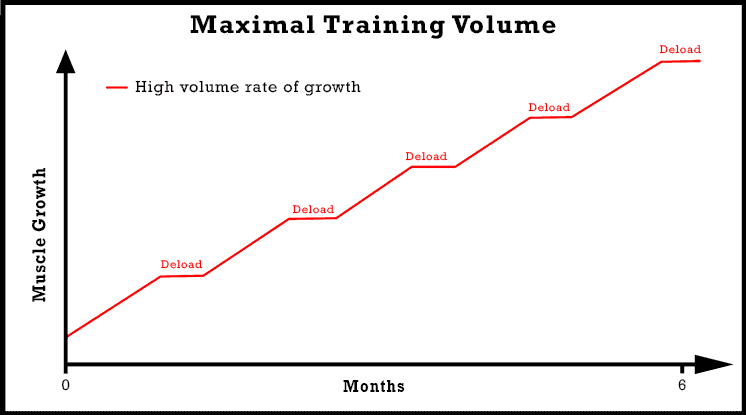
One concern and speculation I have when it comes to the approach of training maximally for a period, and then using deloads to bring down fatigue is that it might be unnecessary.
I think that taking it easier might cause the same long-term results anyways. Simply because you don’t have to use as many deloads in between.
Just like this:
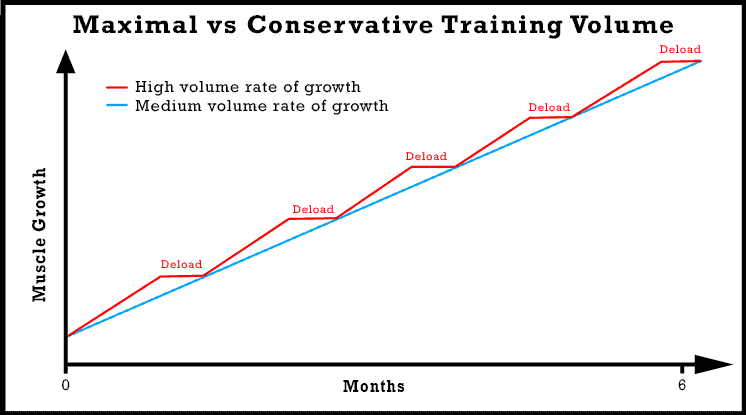
As you can see, both approaches reaches the same end point in muscle growth after 6 months.
The difference is that the high volume approach trains a lot, deloads, trains a lot, deloads and so on. While the medium volume approach makes steady gains without the need of deloads, or at least less of them.
There’s no current scientific evidence (at least not what I can find) currently showing any difference between these approaches.
But based on my own purely logical assumption, taking it easier would provide the same results in the long-term, because you can go at it for longer, with less rest in between instead.
And there’s an upside to this as well, which is that not training close to what you can maximally recover from is likely better for these three reasons:
- It’s safer, both from an injury standpoint and an overtraining standpoint.
- It’s easier both physiologically and psychologically not having to do 15 sets of legs 3 times per week.
- It’s not as time consuming.
Individual Differences
Just because these 11 guys in the high volume group got more gains than the guys in the other groups, doesn’t automatically mean that every individual who’s trained an average of 4.4 years will get the same results.
No, individual differences, mainly genetics, will skew these numbers up and down. Some individuals may get totally crushed from doing 20 sets per muscle group per week.
While others might be able to surpass 30-45 sets per week, and still be able to hammer the work week in and week out. Even though they have the same training experience.
Not only that, food and sleep habits/states, as well as overall daily stress levels, will skew the recovery part of the equation up or down. This will also cause some people to recover better than others, and hence be able to do more work.
Furthermore, even different body parts can handle different amount of volumes. For example, some people need to hammer their lats with tons of sets to make them grow, and they handle it well, while their pecs are smoked, yet grow well from 10-15 sets per week (talking about myself here hehe). And while we’re at it, if you find that your muscles can’t take much beating, but they grow well, it’s time to celebrate!
Why?
Well, for the goal of hypertrophy, you can do less work to get very good results = win, win!
Takeaways and Recommendations
Even though these are two amazing studies. When working as an online coach and personal trainer, it still comes down to each individual when programming how many sets per muscle group and week a person should do.
With that said though, I was very surprised to the fact that the participants in the most recent study, didn’t experience any signs of overtraining at 30-45 sets per week over 8 weeks. As this is much higher than I ever have prescribed for a client. Interesting to say the least!
Okay so finally, here are my initial recommendations for maximizing muscle growth (sets are done within the 5-12 rep range):
- 10-30+ sets per muscle group per WEEK for upper body muscles
- 10-45+ sets per muscle group per WEEK for lower body muscles
As you can see, it’s one heck of a range…
But here’s the deal:
When accounting for all the individual differences, these are the numbers I’m confident recommending based on the evidence just reviewed above.
The biggest factor deciding the amount of volume you should do is training experience. Putting a beginner who just stepped into the gym on 45 hard sets per muscle group per week would be ludicrous.
On the other hand, someone who’s been training for 5 years and are already very muscular, would probably see extremely slow, if any growth from doing “only” 10 hard sets per week.
So, when you decide how many sets per muscle group you should do, you must take all of these things into consideration.
Once you’ve done so, all what’s left to do is trying it out for yourself.
And here’s how:
Progressive Overload – The Key To Long-Term Gains
Finally, before finishing up this post, I quickly want to touch on something that nearly all experts agree on when it comes to natural trainees.
Which is that:
Progressive overload is more important than just “performing volume”.
This means that, if a person is not performing better (getting stronger) in the gym overtime, they’re likely not getting that much bigger either. In fact, as I’ve said before, muscle growth always follow improved training performance and not the other way around.
In other words, the amount of volume you do must be high enough to drive further adaptations. But it doesn’t necessarily need to be higher.
Because, as we’ve already covered; if you do to much volume you will plateau because of overreaching/overtraining (the point at which your body will only be able to recover, not adapt). If you do to little on the other hand, you will only maintain your current musculature because of non sufficient stimulus.
So, a good way to program your training volume is this:
1. Start from the lowest amount of volume that still allows you to improve in the gym consistently overtime.
2. Then once you start to notice gains in performance slowing down, that’s when you add a bit of volume. Sprinkle in 1-2 extra sets per week for the slowed down exercises. This will allow you to start driving further adaptations again.
This approach is great, as you’ll stay away from overreaching/overtraining, you’ll reduce injury risk, and you’ll also be able to rely on small increments in volume to continue getting bigger throughout your training career.
And finally:
Don’t do what I explained in the beginning of this post. Which was doing around 40-50 sets per muscle group per week, during the first year in the gym, after being a sedentary gamer for 5 years… It sucked.
What’s Next?
Okay, so training with at least 10 sets per muscle group per week seems like a good place to start at, then increase the volume by adding a few sets here and there when needed.
But, it’s also important that you do these sets with the best rep range to make sure you’re getting out as much as possible from your workouts. You can read more about the best rep range for growth here!
